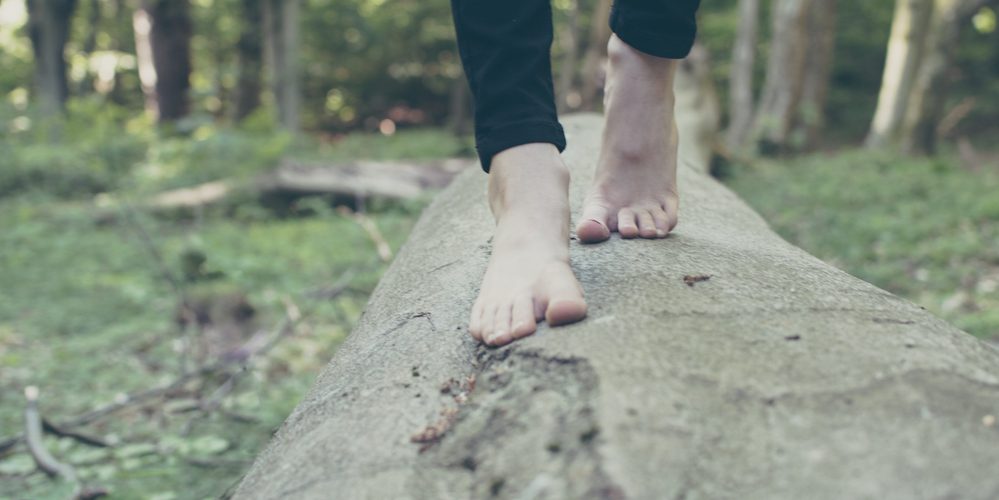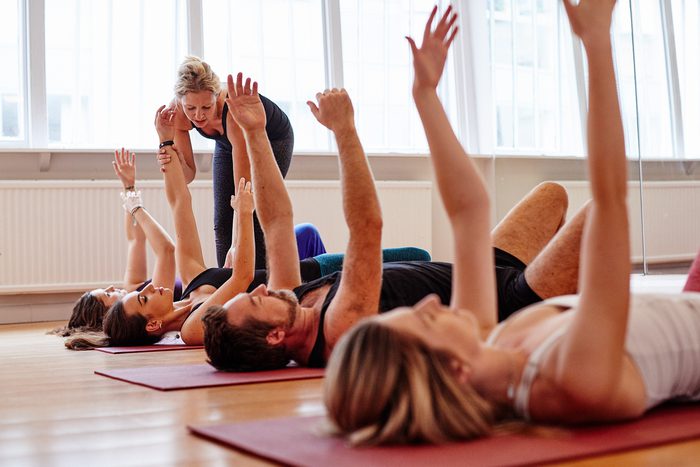Connecting into the fascial matrix
Anatomical study has traditionally separated our structural bodies into muscles and bones. This stems from the work of pioneers like Leonardo da Vinci, whose only way of making sense of the body was through dissection of cadavers. This gave us huge information about the larger, more obvious tissue structures, but involved cutting through the fascia, the intricate and intelligent network in which our skeleton, muscles and organs are suspended and intertwined.
Viewing ‘the core’ through fascia rather than through simple abdominal muscle separation can offer us an integrated view of the body; one that makes more sense alongside what we actually feel and how we most gracefully move.
Of the sensory network of fascia that connects everything in our bodies, myofascia (from ‘myo’ meaning muscle) is that which connects all muscle in long, continuous tracks that run from the bottom of the feet to the top of the body in many lines; both deeper into the body and closer to the skin. This is a system that provides supportive tension, glide for movement in not just muscle, but also under skin, between organs and between joints. There are ten times more sensory nerve endings in fascia than in muscle. This is not just about structure and function, but as yogis have been exploring for centuries, how we can sense our internal landscape and interface with the outer world.
Engaging up from the feet
To have a pliable, hydrated healthy core line, from which we can move fluidly through our fascial pathways, we need to first wake up our feet. Developing pedal elasticity, and especially in our in-steps (pada bandha) allows us to lift up through the whole body; our core originates here. Paying attention to pada bandha in our postural practice – particularly when standing – can create a whole new relationship with the core. Our foot arches act as spring and suspension, giving us bounce, elastic recoil and shock dispersion when they have the flexibility through natural movement When hardening or collapse of the feet reduces this capacity, we feel more shock-waves through the pelvic floor, which then tightens in response and ripples up into tension in the belly and beyond.
“Developing spring and resilience in the soles of the feet helps to provide the structural integrity for the internal organs within the pelvic cavity and in the region of the lower back.” Tias Little [5]
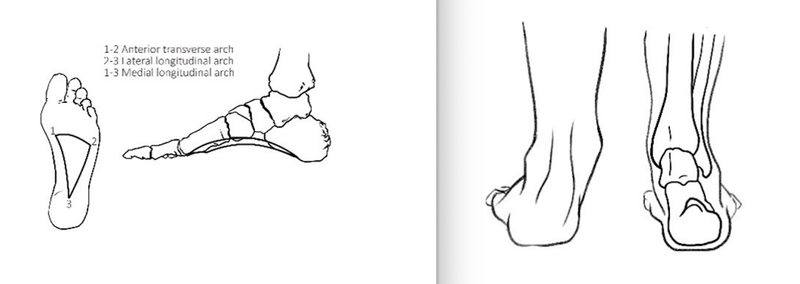
A happy instep (plantar) uplift supports the natural spinal curves above. Dropped foot arches (pronation, see illustration) can leave a person more prone to lower back and neck issues and less able to contain their core, which can lead to organ prolapse; particularly if sedentary behaviours, lack of exercise and excess weight create more downward pressure.
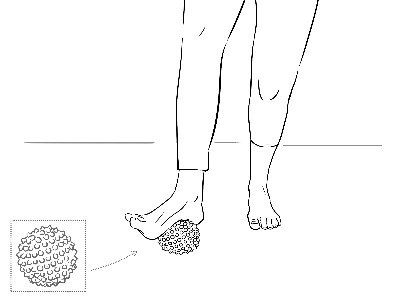
Footwork to improve core balance
- Spread the feet out across the base of the little toe to big toe to create more of a sense of easy uplift, stability and safety. Creating expanse in the triangle from here to the front of the heel, opens the plantar fascia web in the instep. Regularly separating toes (you can use your fingers) and practicing little ‘Mexican waves’ in both directions can help regain and retain this space and movement.
- Roll your feet over a spiky ball to wake up the nerve endings in the soles and engages the sensory input up through the fascia. As you roll the ball, pay attention to what you might feel up into the belly. Stand on one leg, holding onto a chair or to a wall if necessary. Include the heel and outside edge, particularly spending time on the instep. Do each foot separately, standing and then walking between to feel the difference through each leg up from the ground
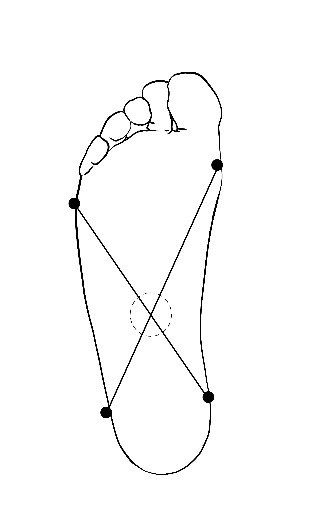
- Visualise the four corners of the foot and draw imaginary diagonal lines: from the outside of the inner knuckle of the big toe to the outside edge of the heel; and from the outside of the little toe to inside heel. The inner foot lifts where these intersect (see illustration). When the arches drop (flat foot or pronation), there is greater tension into the muscles in the lower back, pelvis and spine[6].
- Walk barefoot to regain plasticity and strength in the feet. Little natural walking, shoes and man-made surfaces contort the foot’s natural shape. Overly supportive shoes (especially cushioned and arch-supporting sports shoes) make uplift in the arch of the foot redundant and weaken it over time. Heels raised higher than toes is like tipping a building to its side – it creates great pressure and tension compensation in other areas, most often the sacrum and whole lower back area.
Enlivening this true core connection help us sense internally, but also how that relates to the world around us and how we move through space. It is this core awareness that allows us to tone the deep belly through moving the body in the way that it is best designed, the way it organises itself up from the ground with least strain.
The psoas
When we consider abdominal muscular structure, our core is deeper than the abs – the psoas. This long muscle, reaches up from our inner thighs, through the belly and into the diaphragm, extending to allow us to stand upright and curling us in to protect our heart and belly when we feel scared or vulnerable.
As the only muscle that connects top and bottom body, the psoas has a major role in bipedal standing and walking. It is also critical for alignment and movement, but also for our feelings of well-being. As we gauge its ease or non-ease from deep in the belly, tension in the psoas affects us on a deeply emotional level; it acts as a messenger to and from the brain and stores responses to replay them when we remember, imagine or revisit situations that cause us difficulty.
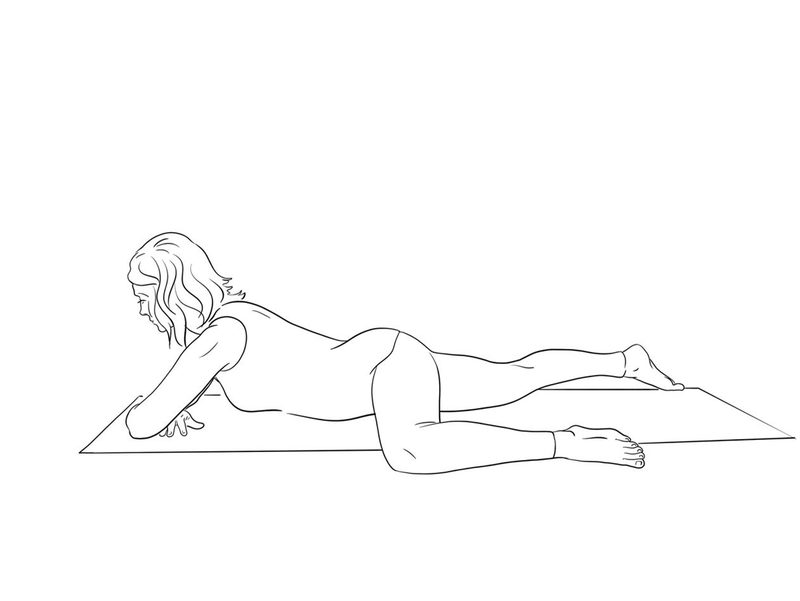
On a functional level, it is the psoas that allows us to move from the core and stabilises us there through its relationship with the lower back. As we rise up from the ground through the channel of the psoas and up through the spine, its health and pliability, its ability to appropriately engage and relax, means we can feel more safe, literally centred.
So having core strength is not about having hard abs, but a connection with our centre and the awareness to be ability to move out from the centre with awareness.
Foot within full function sequence
It is pliability and range of motion in the feet, ankles and lower legs that determine what happens above and how we move without tension and injury. Ankles are designed to quickly absorb force as part of ground stability, then quickly shift and stabilise weight for the next movement, which happens faster than thought. We rely on learned motor patterns and reactions to be able to trust these responses. Preparing our feet for other exercise and moving easily through life can have an all-round effect.
The motions here follow the whole range that the design of our feet can do, from pliability in the fascia (connective tissue), ankle rotation, pointing and flexing our feet to the all-important sucking up of the instep. We can pay attention to how this lift effects sensations up through the psoas and the deep belly.
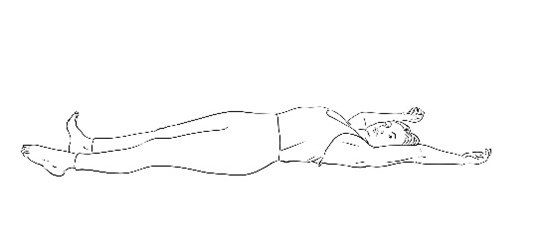
Lying walking motions – upslide/downslide
- Begin lying down.
- Imitate the motion of walking with one foot flexing, the other pointing and move side-to-side. Let the pelvis move with the feet, so the side flexing moves up (hip bone towards head) and that pointing moves down.
- Reach up through the arm of the foot pointing away to lengthen the whole body.
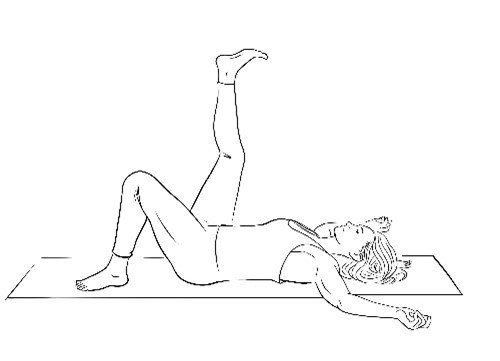
Lying foot motions – leg raised, rotating and pointing/flexing foot
Moving the feet whilst lying allows them full range of motion without body weight onto them. It also allows any fluids pooled in lower legs and feet to easily drain out with gravity.
Simply lying with legs up onto a chair or sofa also has this effect.
- Lie with the ankle above the hip (bend knee as needed).
- Rotate the ankles fully in both directions
- Point and flex each foot for at least a minute.
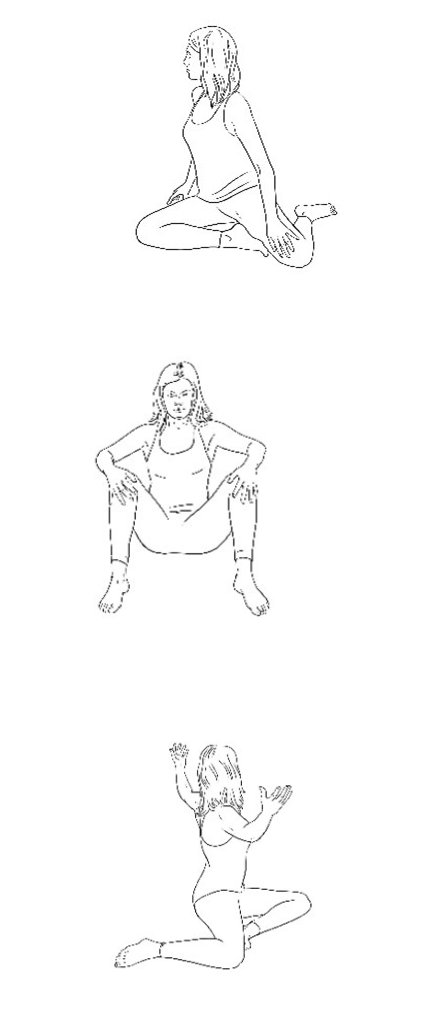
‘Z-legs’ moving twist
- Sit with knees bent and wider than your hips, let your knees both drop to one side to come into a ‘z-legs’ seat.
- Move knees side to side, feeling how it comes both from your belly and your feet.
- You can build from here, eventually moving further round each time with arms open wide.
- You may move forward as the feet find a natural walking motion.
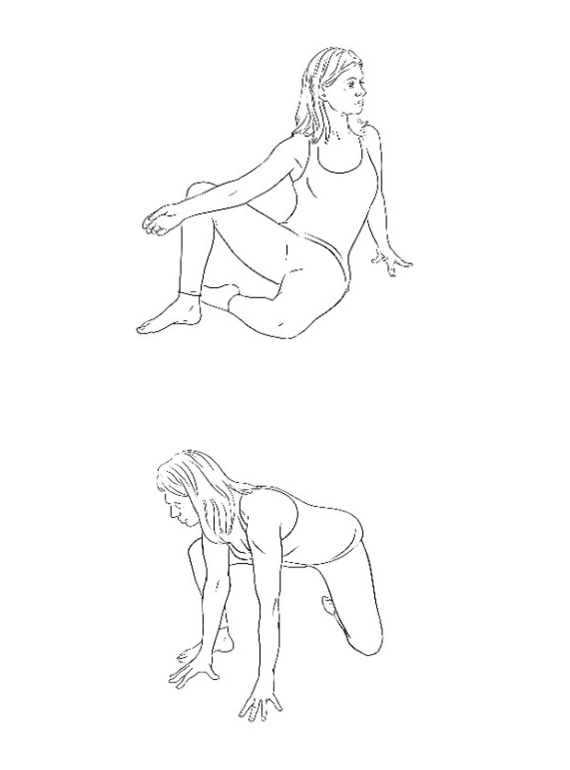
‘4’ shape stepping into lunge
- Sit in a ‘4’ shape with one foot crossed over the other.
- Move this side-to-side, turning away from the legs in a gentle twist.
- Once used to this motion, stepg the foot further away and shift your weight forward towards a natural lunge.
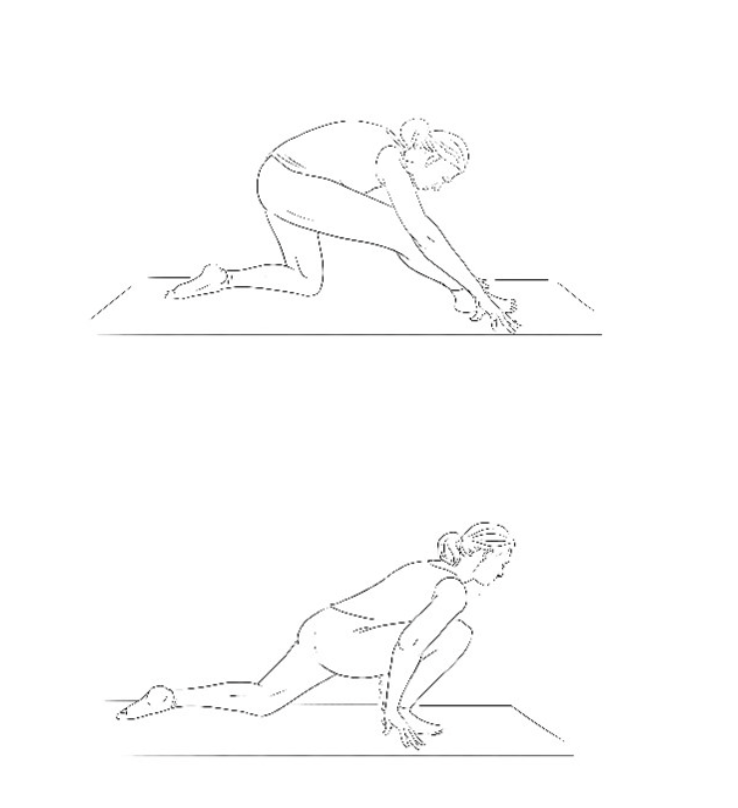
Low lunge with front ankle focus
- From all fours, step one foot between the hands (or step back from hands on a chair if you need a higher version).
- Keeping the whole front foot planted to the earth, rock forward and back to feel weight onto the ankle as you create pliability there.
- Repeat on the other side.
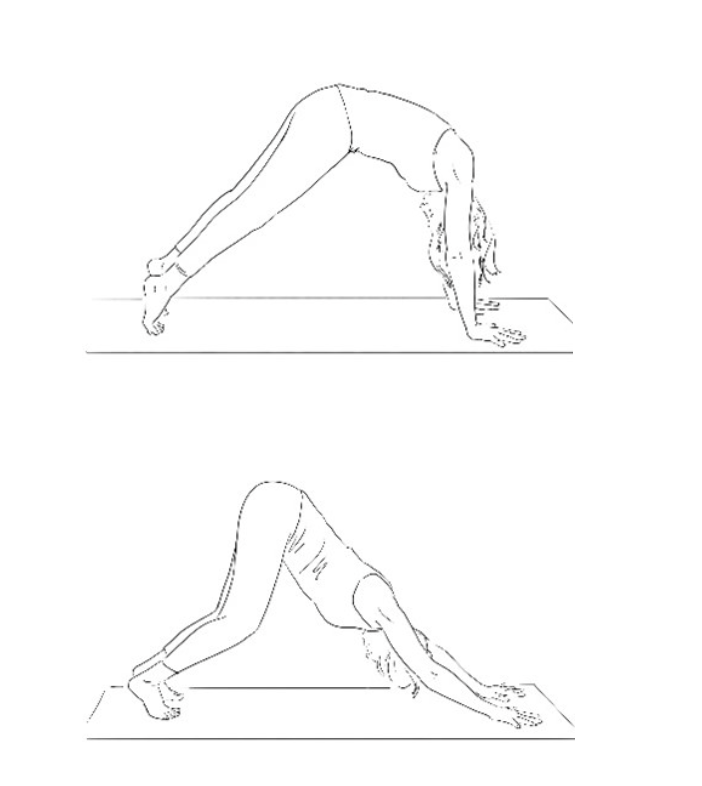
Downface dog with bent knees
- From all-fours, lift the knees and hip towards downwards-facing dog position, with open hands to support the weight back through the shoulders.
- With heels high, move between knees bent deeply and belly towards thighs, to legs straight, shoulders above wrists and lifting up onto the toes.
- Move forward and back through the feet. Feel how the core opens and contracts and the relationship between the feet.
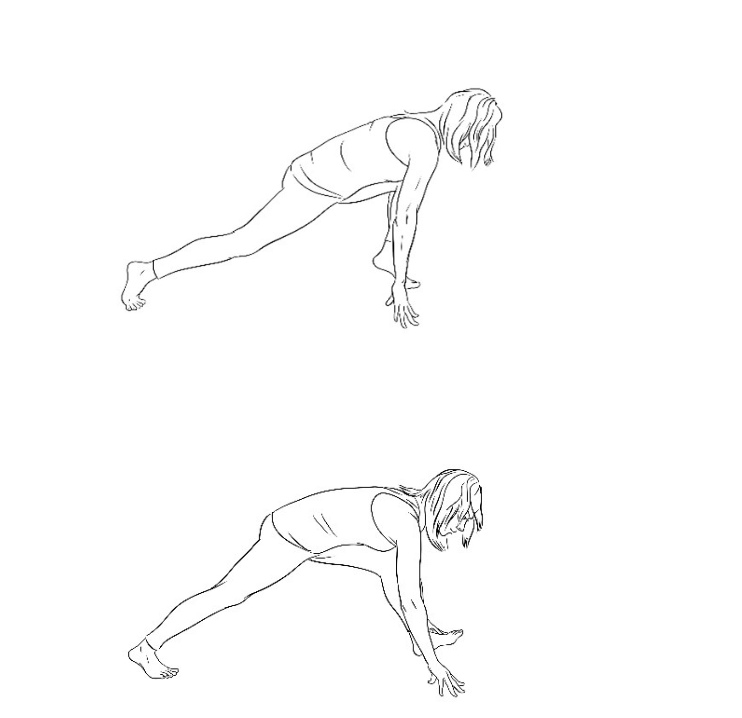
Low lunge with foot walking action
- Step one foot between the hands (feet hip-width apart and parallel).
- Keep the back knee up and allow the foot to move; heel lifting as hips come forward and ball of the foot lifting as they come back.
- Take your time to feel this walking motion and the shifts in weight distribution on each foot.
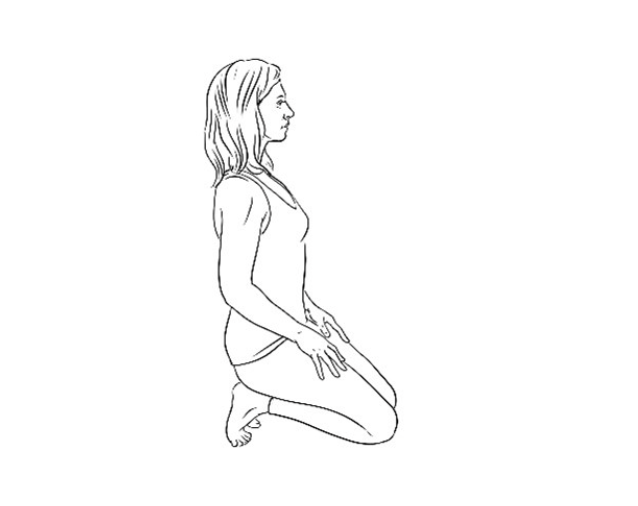
High-heel sitting
Sit back onto your heels with toes tucked under, even for just a few breaths – you may need to start on all-fours before lifting up the torso and you can start with one foot at a time if needed. This opening the backs of the toes can feel rather difficult as tissues tend to be tight there, but breathing out fully (even sighing) with the sensations can help stay with soft jaw.
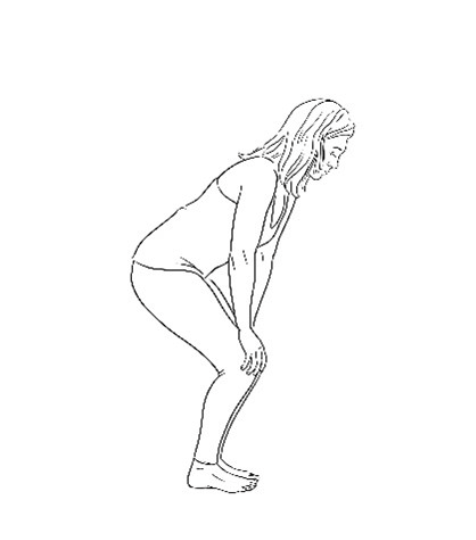
Qigong standing rotating ankles
- Stand feet together, bending your knees with hands on thighs.
- Rotate knees and ankles in one direction and then the other.
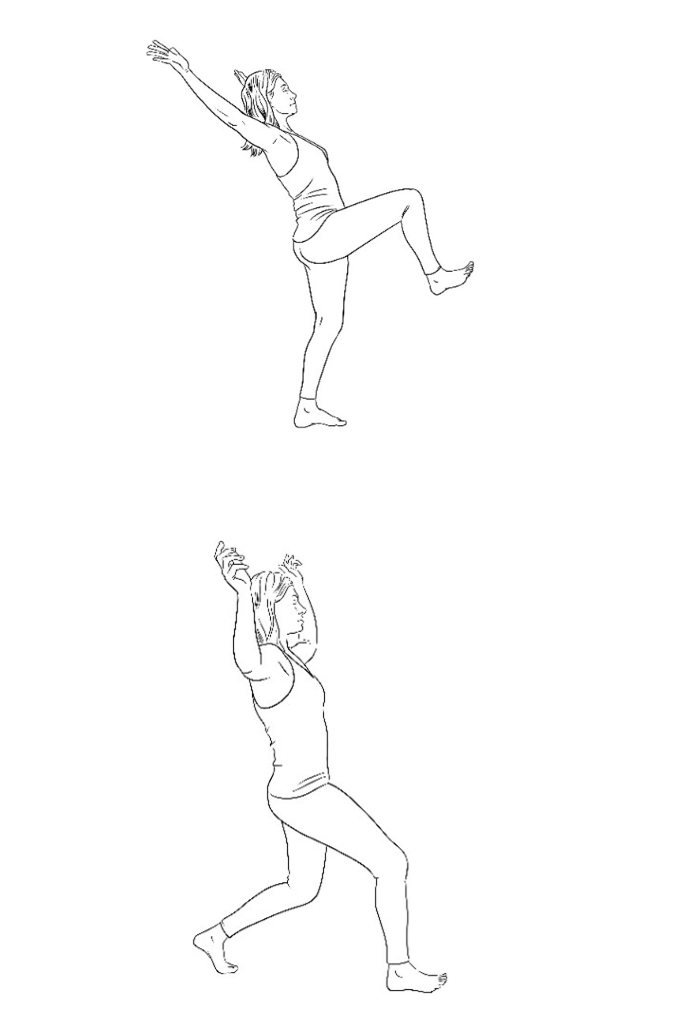
Stepping motion
- Feet hip-width apart, feel your stance above your feet and then with an inhale, lift one knee and place the foot down with an exhale; move this side-to-side.
- As you find your balance (with a steady gaze and breath) you can begin to bend the standing leg more to step forward into a lunge and reach forward with rounded arms.
- You will need a bit of space to keep striding with the breath, but you can turn corners and explore the motion – you can do this outside with thin-soled shoes.
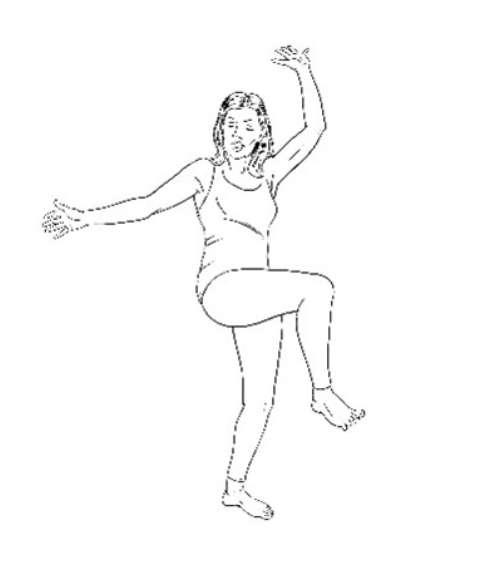
Free-form balance
Lift one leg and explore balance without any agenda, just in a playful way, to wake your feet up to adapt the constant change. Hold a wall or chair if you need, but let the weight drop onto the standing foot as often as possible. You don’t need to ‘get it right’, you’ll likely put the other foot down or even stumble a little!
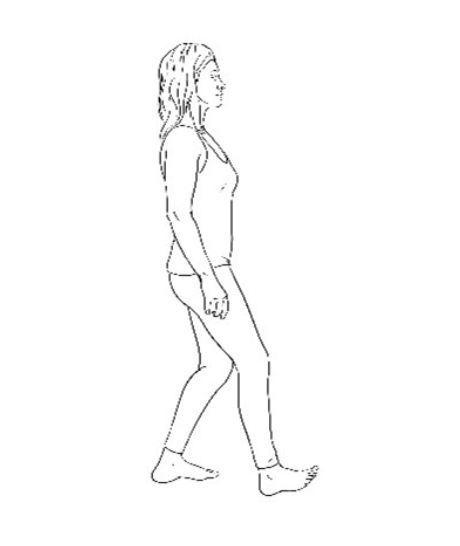
Walking meditation
Our feet are built for walking upright and walking meditation helps us to tune in to the sense of moving and placing of the feet and legs. This can then move to sensing lightness of the foot when lifting it, movement of the foot pushing forward, heaviness when it descends and then the touch of the heel on the ground. You can do this at home to support more sensory awareness when walking outside.
